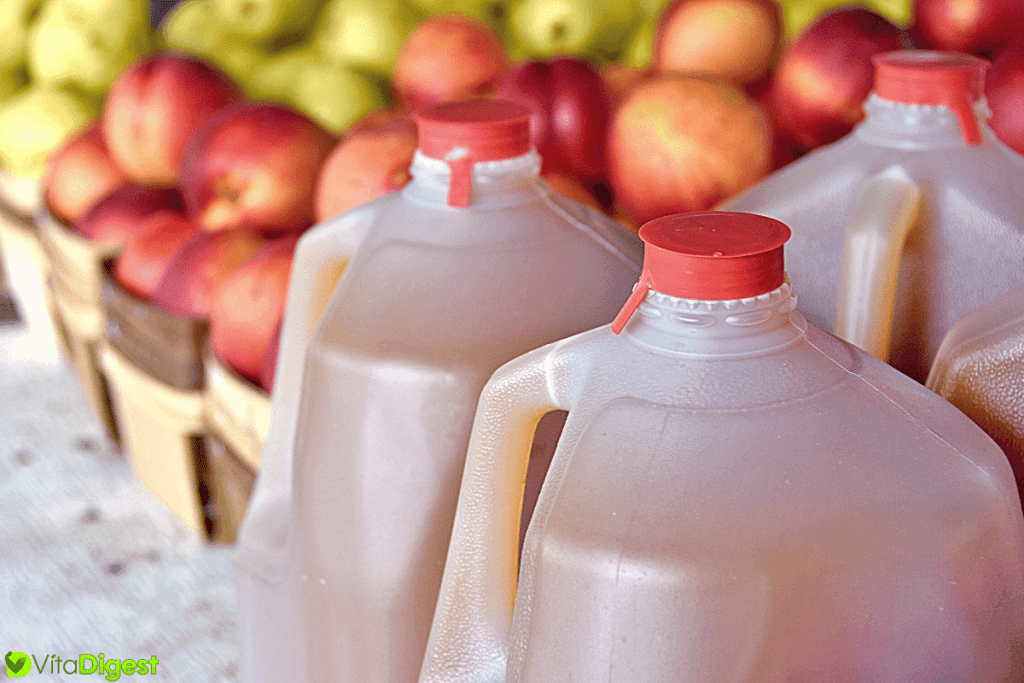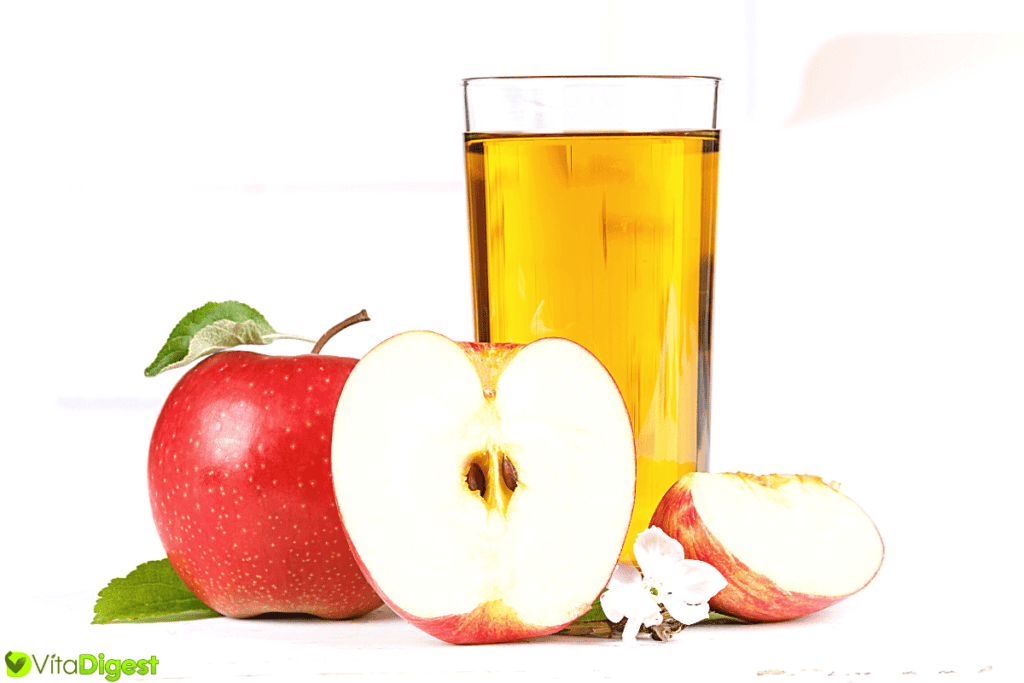Ever wondered what sets apple cider apart from apple juice? Both drinks come from the same fruit, but their tastes, production processes, and uses are worlds apart. Apple cider is typically less filtered with a stronger, more robust flavor, that is often associated with fall and festive activities. On the other hand, apple juice is more refined, with a lighter, sweeter taste that is a staple in many households year-round. In comparing apple cider vs apple juice, the main difference lies in the production process, and this distinction results in two beverages with unique tastes, textures, and nutritional profiles.
What is Apple Cider?
When we think of fall, apple cider often comes to mind. This apple-based beverage is a seasonal favorite that packs a flavorful punch. Apple cider is a drink made from crushed and pressed apples. Unlike apple juice, it’s unfiltered, resulting in a cloudy, amber-colored liquid.
It’s robust in flavor, slightly tarter compared to conventional apple juice, and contains pulp and sediments which give it a unique texture. While apple cider can be enjoyed both in a non-alcoholic and alcoholic version, in the United States, the term typically refers to the non-alcoholic variety made from apples. The alcoholic version, similar to apple wine, is often referred to as “hard cider.”
How is Apple Cider Made?

The production of apple cider involves a simple, time-honored process that enhances the natural flavor of apples. Starting with whole, ripe apples, the process goes as follows:
- Selection and Washing: Producers select a blend of apples to achieve the desired taste. The apples are thoroughly washed to remove any impurities.
- Crushing and Pressing: The apples are ground into an “apple mash” similar to applesauce. The mash is then pressed to squeeze out the liquid.
- Fermentation (Optional): For “hard” ciders, the liquid is left to ferment for weeks to months. Natural yeast consumes the sugars in the cider, producing alcohol and carbon dioxide.
- Pasteurization: The cider is typically pasteurized to kill any harmful bacteria and extend shelf life.
Operationally, the essential principle of cider making is to extract as much juice from the apples, trapping the rich flavors from the pulp, skins, and seeds. This is what gives apple cider its distinct, robust taste and its cloudy appearance.
It’s also worth mentioning that apple cider contains more nutritional value than apple juice due to its less processed nature. A serving of apple cider is a good source of potassium and vitamin C, also known as ascorbic acid. Understanding the creation and nutritional value of apple cider provides an intriguing look into why this beverage is a beloved seasonal favorite.
What is Apple Juice?
Apple juice, as the name implies, is a liquid extract of the apple fruit. Known for its crisp and sweet flavor, apple juice is usually amber in color with a clear and light consistency. Apple juice is more refined and processed than apple cider, with its primary characteristic being its consistent lack of pulp or sediments. This level of filtration and refinement gives apple juice a longer shelf life than apple cider.
How is Apple Juice Made?
The production process of apple juice is quite straightforward yet meticulous. Here’s a step-by-step breakdown of how we get apple juice from farm to table:
- Apple Selection and Washing: The apples are chosen, cleaned, and carefully inspected for quality. Only the best ones make it to the juice production.
- Crushing and Pressing: The apples are then crushed and pressed to extract the rich flavorful juice. The entire apple, including the skin and the core, is used in this process to ensure maximum yield.
- Filtration: The extracted juice goes through a rigorous filtration process. Here, pulp, sediments, and other impurities are removed to give the juice its clear appearance.
- Pasteurization: To ensure longevity and safety, the juice is pasteurized. This process involves quickly heating the juice to kill off any harmful bacteria, yeasts, or molds.
- Bottling: Finally, the juice is bottled and sealed, ready for consumption.
Just like apple cider, apple juice also boasts a robust nutritional profile. A single serving of apple juice can provide a good amount of vitamin C, potassium, and other essential nutrients. Apple juice also contains a fair bit of antioxidants, which contribute to overall health benefits.
What Sets Apple Cider Apart from Apple Juice?

We have discussed the intricate details of apple juice already. Now, let’s explore what makes apple cider unique.
Ingredients
If you look at the ingredients, apple cider is arguably less refined than apple juice. Freshly picked apples are all you need to make it. You won’t find any added sugars, preservatives, or artificial flavors in a traditional cider. This natural recipe is what separates apple cider from its juice counterpart. The flavors and health benefits come directly from the apples themselves.
Production Process
The production process of apple cider adds to its unique charm. Unlike apple juice, which undergoes filtration and pasteurization, cider involves just pressing and fermenting the apples. The juice or “cider” obtained from this process will have a lot of pulp and possibly some apple bits. There’s no pasteurization involved, so the cider may have a less predictable and noticeably shorter shelf life than apple juice.
Taste and Flavor
When it comes to taste, apple cider tends to have a tangier, more robust flavor. It’s not as sweet as apple juice due to the lack of added sugars. Meanwhile, its texture is much thicker and chunkier, which might be positive or negative, depending on personal preference.
Nutritional Differences
There are also some key nutritional differences between these two apple beverages. According to USDA data, one cup of apple cider contains almost the same amount of calories and sugar as apple juice. However, because it’s not processed and retains apple pulp, the cider has more dietary fiber. Apple cider also tends to have more potassium and vitamin C due to the lack of heat treatment, which can strip these nutrients from apple juice.
| Beverage | Calories | Sugar | Fiber | Potassium | Vitamin C |
|---|---|---|---|---|---|
| Apple Cider | 117 | 28g | 0.5g | 294mg | 2.4mg |
| Apple Juice | 115 | 24g | 0.2g | 250mg | 2.2mg |
In the end, it all boils down to personal preferences and dietary considerations. Whether you pick cider or juice, you’re still getting a good dose of refreshing apple goodness.
Which One Should You Choose?
When it comes to choosing between apple cider and apple juice, there are several factors we need to consider. While both beverages come from the same source, the differences in their production process result in distinct flavors, textures, and nutrient profiles.
Dietary Considerations
When we’re thinking about our health, it’s crucial to take into account the nutritional components of the apple products we’re consuming. As we mentioned earlier, apple cider is less refined and contains a higher amount of dietary fiber, potassium, and vitamin C compared to apple juice.
However, despite its robust flavor and additional nutrients, cider also comes with a shorter shelf life due to less processing. The fermentation process in cider production can also contribute to its probiotic content, potentially supporting gut health. But keep in mind, that this fermented beverage might not be suitable for everyone, particularly those with certain digestive conditions.
On the other hand, apple juice is heat-treated, resulting in a longer shelf life. It’s also free of pulp, which might sit well with people who prefer a less chunky and more refreshing beverage. However, the heat treatment it undergoes could strip away some nutrients, leaving it with slightly less dietary fiber, potassium, and vitamin C.
Personal Preferences
The choice between apple cider and apple juice often comes down to personal preference. If you’re a fan of strong, tangy flavors and don’t mind a bit of pulp, apple cider might be your go-to. Its unique flavor profile and hearty texture are well-received by those looking for a taste of the harvest season in a cup.
But if you’re seeking a clear, sweet, and smooth beverage that you can store for a longer time, apple juice might be the better choice for you. Its homogenous consistency and refreshing sweetness make it a crowd-pleaser, particularly among kids.
Remember, both apple cider and apple juice have their own unique benefits and drawbacks. The final choice would still be dictated by your own dietary needs, taste preferences, and finding the right balance.
